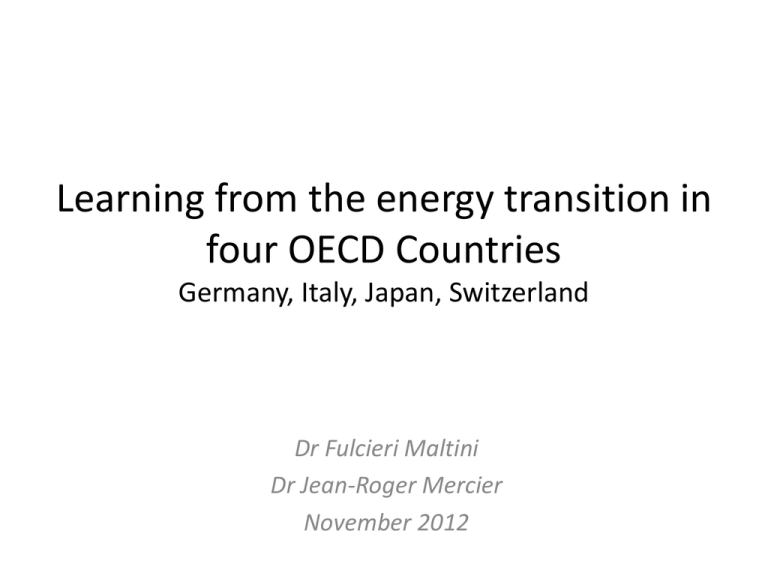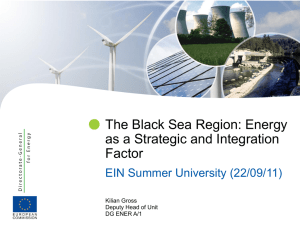Learning from the energy transition in four OECD Countries
advertisement

Learning from the energy transition in four OECD Countries Germany, Italy, Japan, Switzerland Dr Fulcieri Maltini Dr Jean-Roger Mercier November 2012 Overview • Germany, Italy, Japan and Switzerland are currently implementing an energy transition away from nuclear power and giving priority to energy conservation and renewables, • Motivations behind these transitions vary and so do their pace, costs and fundings, • This presentation tries to distill lessons from these transitions that can apply to Europe and France. Germany - background • Historically, a divided country after WW2 reuniting in 1990 and requiring high power supply for its reunification and industrial development: 4,140 TWh/year in 1990 • Politically, a strong surge of the Green party (« die Grünen ») that makes, from the onset, nuclear phasing-out as one of its key targets • A strong energy efficiency policy has allowed a 10% power demand reduction, with only 3,715 TWh consumed in 2011 Germany - Strategy • In 2000, the socialist-green coalition puts a moratorium on nuclear power in the country • The decision is reversed by the Merkel Government in 2010, at a time when nuclear produces 11% of Germany’s primary energy • And in 2011, the political decision comes to phase out nuclear entirely with several potential deadlines, Germany – the plan(s) • Energiewende (energy transition) becomes a household name and the world looks at Germany for guidance and enlightment • March of 2011: 8 nuclear plants are closed down • Summer of 2011: the legal package adopted projects the end of nuclear generation by 2022 • Many challenges have been identified Germany – objectives for 2050 • Greenhouse Gas (GHG) emission reduction: 80 to 95% (ref. 1990) • Renewables in the overall energy balance 60% • Ditto in gross power production 80% • Primary energy production (ref 2008) - 50% • Electric power consumption (ditto) - 25% Germany 2050 – Renewables • Lion’s share to wind 170 TWh (113 offshore) • Biomass and photovoltaics 40 TWh each • Hydro: stable at 24 TWh In all, 80% of domestic power production, and needing creative network management to compensate for volatility Another huge challenge: extending the transmission grid at a pace of 470 km/year vs 35 at present. Opportunities and euros • The decentralized management of the country opens up great local opportunies and several « cantons » are already generating more energy than they consume (« positive energy ») • DIW’s prognosis: up to 800 billion € to spend over the coming 50 years. Increases of consumer prices have begun and are confronted with criticism and protests. Italy - Background • End of WW2: Italy relies almost exclusively on hydro (88% of power generation) • 1990: thermal power has taken over the lead (63%), with hydro down to 16% and electricty imports making up for the rest (12%) • After a brief attempt to develop nuclear, the Italian people, in a 1990 referendum following Chernobyl, reject further nuclear power development. Italy – the historic referendum • Under the pressure of the French, the Berlusconi government embarks on a new referendum in 2011, hoping to reintroduce nuclear • Over 90% of the voters reject nuclear again and the Italian government moves forward • Targets of 17% renewables by 2020, inferior to the European average, are set Italy – Local Power • After the referendum, municipalities and regions are encouraged to develop their own power generation/conservation programs • By2012, over 400,000 local power generation units of various dimensions were operational across the country and over 95% municipalities, large cities as well as small villages, were equipped with multiple sources of energy mix Italy – Renewable present • Growth in the number of municipalities equipped with renewable energy generation is spectacular: from 3,190 in 2008 to 7,986 in 2011, • As a result, Italy comes second in Europe for solar power generation (12,750 MW vs 24,700 for Germany) • Energy mixes are adapted to local resource availability (solar, wind, biomass, geothermal, hydro) Italy – the pionneer • Large solar thermal power generation plants are also being installed and run: 30 MW in Sicily in operation, more planned in this range • Wind farms are multiplying and Italy is third produced behind Germany and Spain • Biomass use is maximized with various substrates and processes: e.g. fermentation of wine production by-products, biogas distribution in local natural gas grids, biogas in vehicles, …. Italy – more good news • Energy efficiency and conservation are highly developed • Smart grids and smart meters (over 30 million units sold and installed) complement the approach • As of 2012, 23 municipalities were selling more energy than they were producing • Energy storage is diversified and is putting Italy at the forefront of this critical element of Energiewende. Italy – Towards 2020 - Objectives • Primary energy demand - 4% (reference 2010). • Stable power demand • Renewables 20% of final energy demand and 38% superior of gas’s • The required 180 billion € investment to be allocated at 72% for renewables and remaining 28 % for conventional sectors (extraction, oil & gas production and transportation, GNL regazeification and thermal power plant construction) Japan – Recovering from the trauma • The third largest power consumer in the world, Japan started, in the late 40’s with a simple energy mix: coal 50%, hydro 33%. • In the early 70’s, nuclear comes into the picture and is hailed as a miracle source for an oil importer, • Nuclear share in power production grew from 4% in 1973 to 24% in 2009 in spite of activists’ protest, overheated after each nuclear accident (TMI, Chernobyl) The Fukushima turning point • The vast majority of Japanese, however, were following suit with the nuclear lobby, very well organized under the auspices of the powerful Nippon Keidanren • 54 nuclear power plants were in operation in early 2011, • And then Fukushima happened and, beyond the human/economic drama, exposed the lack of preparation and the ineffectiveness of TepCo and the Japanese Government Eighteen months later… • The situation is yet to be stabilized in Fukushima and surroundings (e.g. sea pollution) • The Japanese government, under the pressure of the street, had to revise and deeply modify its energy plans • All nuclear plants were closed and their production rapidly substituted with thermal plants Prospects • Japan will have difficulties meeting its carbon emission reduction targets if the ban on nuclear is confirmed • The new target (- 20% by 2030 vs the previous – 25% by 2020) is heavily critized by local activists • Japan plans to spend nearly 500 b US$ on renewables in the coming two decades • No cost estimate for Energiewende seems to have been produced/discussed Switzerland - background • After WW2, the country was relying primarily on hydro, then attempted to introduce nuclear • The accident at the Lucens nuclear experimental power plant in 1969 killed the public sector program • In parallel, between 1969 and 1984, the private sector built five nuclear power plants that are in operation and provide 3.2 of the 20 GW national power demand Switzerland after Fukushima • March 25, 2011, the Federal council opts out of nuclear, programming the closing of the 5 existing plants between 2019 and 2034, possibly earlier for Mühlenberg that has similar features with Fukushima • The Federal Government is actively preparing a national energy law to be adopted by Parliament in end of 2012 and subjected to referendum in 2014 Key features of the Energiewende • Focus on energy efficiency, with targets of demand reduction of 70 TWh and 20 TWh resp. for total energy and electricity demand reduction by 2050 • Priority to energy conservation measures in houses and offices • Reliance on rapid take-off of a variety of renewables Noteworthy 2050 targets • • • • • • Photovoltaics Wind Geothermal Wood biomass Biogas Hydro + 10 TWh + 4 TWh + 4.4 TWh + 1.1 TWh + 1.4 TWh + 3.2 TWh Parallel processes • Three « popular initiatives » launched – Closing of all nuclear plants by 2023 – Cleantech: to accelerate energy efficiency and renewables development – Ecological fiscal reform • Several « cantons », opposed to nuclear, have set their own bans (e.g. Geneva which gets 87% of energy from renewables and imports the rest) Costing • The Cleantech initiative has been costed by the University of Lausanne • The losers would be importers (0.6 billion CHF over 2012-2030, power producers 3.1 and the Federal Treasury 2.1)… • In exchange for 21-26 b CHF increase in GDP, or 2% and the creation of 15,000 jobs What lessons for France and Europe? • France lives in the economic crisis mode. The Fukushima shock has largely been forgotten and the nuclear lobby is strong as ever • France is, however, increasingly isolated in the refusal of the Energiewende • In the four countries studied here, the Energiewende is in place and central as well as local governments are marching. France’s centralization is also a handicap. France and Europe • Adding to the French delay is the inertia of a system that took 11 years to transpose the European Directive 2001/42 on the environmental assessment on plans and programs in the energy sector • The only viable solution can come from Europe, which has the tools and mechanisms to help integrate these Energiewende into a stable and effective system. Will there be the politicial will?






![The Politics of Protest [week 3]](http://s2.studylib.net/store/data/005229111_1-9491ac8e8d24cc184a2c9020ba192c97-300x300.png)
